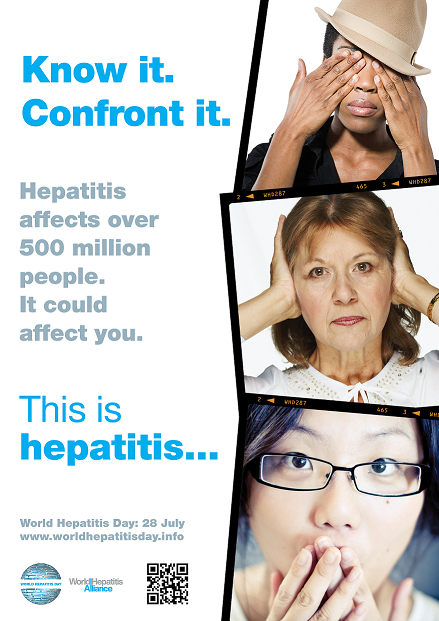 Welcome to PAN’s July review of What’s HOT in Research! In honour of World Hepatitis Day on July 28, this posting will focus on hepatitis C research. Hepatitis is often known as the “silent killer” so on this World Hepatitis Day the call is to “Know it, confront it!”
Welcome to PAN’s July review of What’s HOT in Research! In honour of World Hepatitis Day on July 28, this posting will focus on hepatitis C research. Hepatitis is often known as the “silent killer” so on this World Hepatitis Day the call is to “Know it, confront it!”
- First, let’s start with the epidemiological data, which is one way we have of measuring trends. The World Health Organization (WHO) estimates that 2%-3% of the world’s population is infected with the hepatitis C virus (HCV). In Canada, the Public Health Agency of Canada’s 2010 reported cases of HCV have declined in Canada in recent years. However surveillance report, the health care burden presented by existing cases that progress to more serious sequelae continues to escalate. In 2009, 11,357 cases of HCV were reported, corresponding to a rate of 33.7 per 100,000 population. This rate has decreased since 2005 (40.5 per 100,000). The majority of cases are over the age of 30 years and among males, but the gender gap is narrowing, which is mainly driven by increasing rates in younger females. In British Columbia, greater than three per cent, or more than 120,000 people in are hepatitis B and/or C-infected. For a more detailed look at the rates of hepatitis B and C in BC, read the BC Centre for Disease Control’s 2011 annual summary.
- Treatment as prevention for hepatitis. Those in the HIV/AIDS field are familiar with the buzz around treatment of HIV/AIDS as prevention, or TasP for short. In March of this year, the provincial government announced $1.5 million in one-time funding to the St. Paul’s Hospital Foundation to explore ways to better address both hepatitis B and C epidemics in BC. They are hypothesizing that applying the TasP approach to hepatitis could simultaneously prevent liver disease and avert further transmission of the disease, multiplying the beneficial impact of treatment. This advancement will no doubt transform responses to hepatitis in our province. CATIE has written an article about TasP and HCV here, if you’d like to read more!
- New treatment options for hepatitis C, and HIV and hepatitis C co-infection, often make the headlines. For quality information on treatment, the CATIE website is an important source of information in Canada. Recently, they posted on the fact that new cures for hepatitis that are coming down the pipeline are expected to be much easier to take. They report that these treatments, which are being tested in clinical trials right now, aim to increase the cure rate, shorten the treatment time, decrease side effects and cut the number of doses taken per day – good news for the approximate quarter of a million Canadians with hepatitis C. While questions around availability, treatment guidelines, and cost are yet to be answered, these advancements point to a future where most everybody will be able to be cured.

Questions? Feedback? Get in touch!
Andrea Langlois
Community-Based Research Manager
[email protected]
Twitter: @PAN_CBR
